The CAGED System
By Vicki Lynn
The CAGED system is a way to memorize the finger positions for guitar chords A, C, D, E, and G. You can play chords higher up on
the fretboard by playing the next CAGED sequence. The lower notes of the next sequence will always overlap the previous sequence.
The CAGED system applies equally to rhythm and lead guitar and is beneficial in learning chords, scales, arpeggios, and other
concepts. It does not matter if you play an acoustic, or an electric guitar, or play country, rock, blues, jazz, or any other
style of music, the CAGED system applies equally.
There are 5 basic open chords in the CAGED system, C major, A major, G major, E major, and D major. See Image One below.
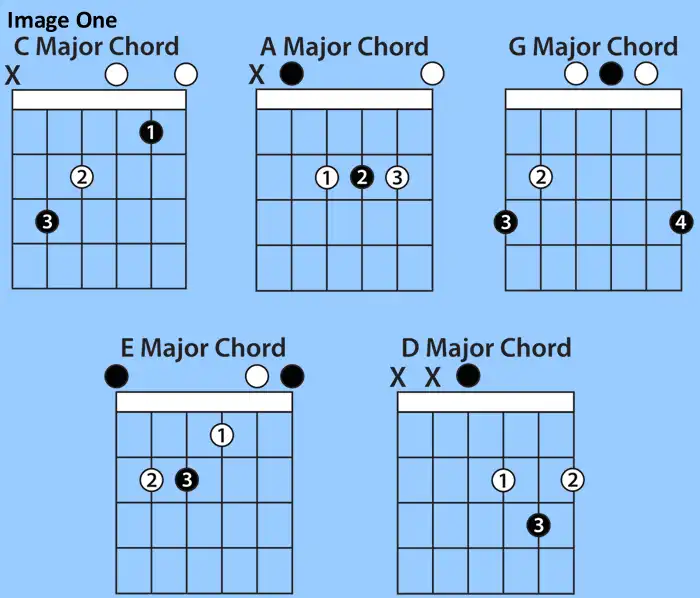
The open chords in Image One are movable down the fretboard. The two bar chords in Image Two below are the 6th string root note
E major bar chord and the 5th string root note A major bar chord.
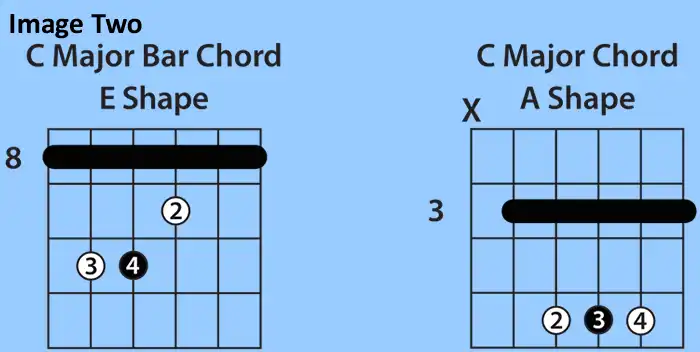
You can change chords just by moving up or down the fretboard. You can move the C chord up two frets barring it at the 2nd fret,
and it becomes a D chord. And the G chord and D chord can likewise be moved up the fretboard. See Image Three below.
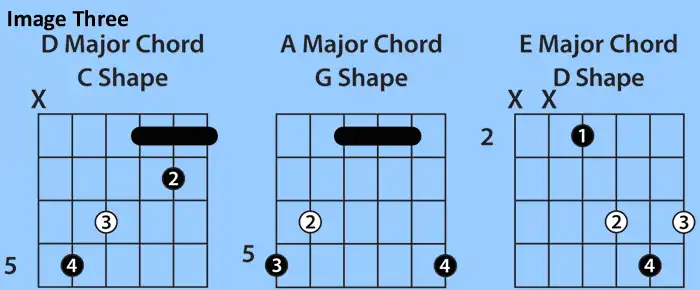
The C chord becomes the basis for the C shape, which can be linked to other chords moving up the fretboard. See Image Four below.
Next, we will use an A shape to play a C chord. By moving the chord down to the next root note it becomes the root of the next
chord shape. See Image Five below.
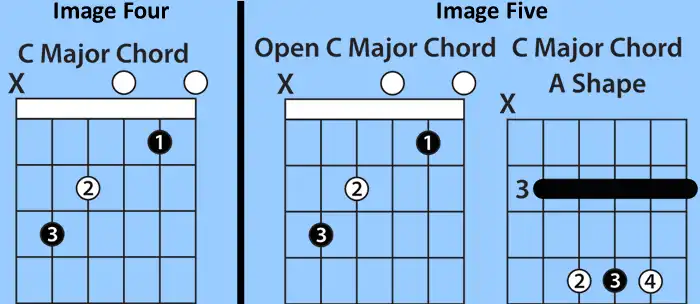
By visualizing the C shape and A shape together and remembering the root notes you can better memorize each shape. See Image
Six below.
The G chord shape can be accomplished by moving the A shape further up and using the root note in the G shape. See Image Seven below.
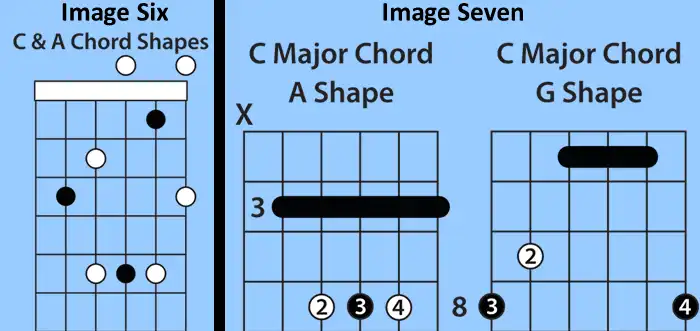
You can combine the A shape and the G shape and remember their shapes as one, and where the root notes are located. See Image
Eight below.
The E chord shape is a standard E bar major chord. See Image Nine below.
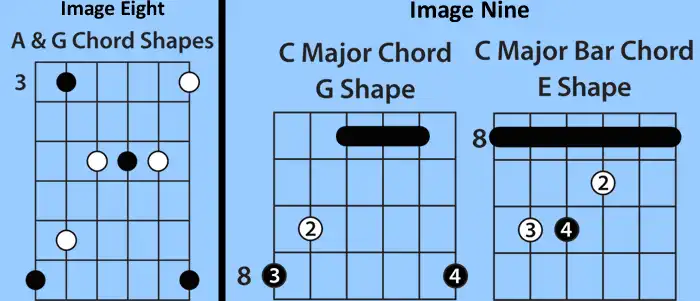
Visualize the two shapes together and move them up and down the fretboard between the two shapes. And again, remember the root
notes. See Image Ten below.
The last shape is the D chord shape. Find the highest root note in the E shape and use it as your lowest note in the D shape.
See Image Eleven below.
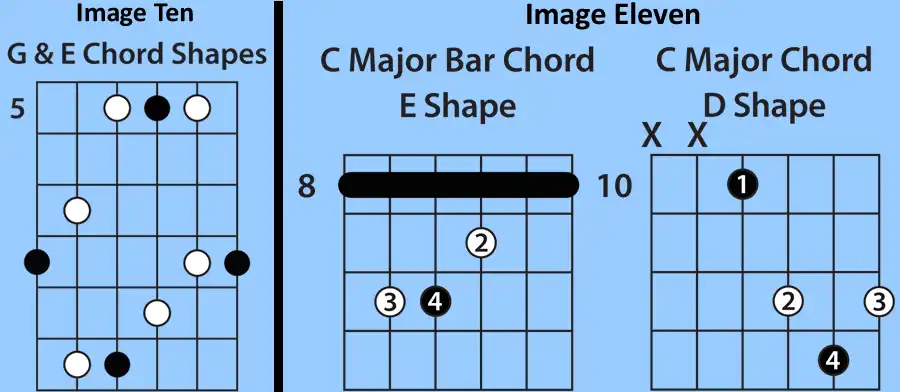
Combine the shapes, remember the root locations, and practice moving between the two shapes. See Image Twelve below.

Add Comment
Insert Bullet List
Please enter at least one item.
Item:
Item:
Item:
Item:
Item:
Insert Numeric List
Please enter at least one item.
Item:
Item:
Item:
Item:
Item:
Insert Link
Please enter the link of the website
Optionally you can add display text
Insert Email
Please enter the email address
Optionally add any display text
Insert Image
Please enter the link of the image
Insert YouTube Video
Please enter the link of the video
Image Upload
Privacy Policy
This policy contains information about your privacy. By posting, you are declaring that you understand this policy:
- Your name, rating, website address, town, country, state and comment will be publicly displayed if entered.
- Aside from the data entered into these form fields, other stored data about your comment will include:
- Your IP address (not displayed)
- The time/date of your submission (displayed)
- Your email address will not be shared. It is collected for only two reasons:
- Administrative purposes, should a need to contact you arise.
- To inform you of new comments, should you subscribe to receive notifications.
- A cookie may be set on your computer. This is used to remember your inputs. It will expire by itself.
This policy is subject to change at any time and without notice.
Terms and Conditions
These terms and conditions contain rules about posting comments. By submitting a comment, you are declaring that you agree with these rules:
- Although the administrator will attempt to moderate comments, it is impossible for every comment to have been moderated at any given time.
- You acknowledge that all comments express the views and opinions of the original author and not those of the administrator.
- You agree not to post any material which is knowingly false, obscene, hateful, threatening, harassing or invasive of a person's privacy.
- The administrator has the right to edit, move or remove any comment for any reason and without notice.
Failure to comply with these rules may result in being banned from submitting further comments.
These terms and conditions are subject to change at any time and without notice.
{"commentics_url":"\/\/skoukor.com\/cmt\/","page_id":355,"enabled_country":true,"country_id":0,"enabled_state":true,"state_id":0,"enabled_upload":true,"maximum_upload_amount":3,"maximum_upload_size":5,"maximum_upload_total":5,"captcha":false,"captcha_url":"","cmtx_wait_for_comment":"cmtx_wait_for_comment","lang_error_file_num":"A maximum of %d files are allowed to be uploaded","lang_error_file_size":"Please upload files no bigger than %.1f MB in size","lang_error_file_total":"The total size of all files must be less than %.1f MB","lang_error_file_type":"Only image file types are allowed to be uploaded","lang_text_loading":"Loading ..","lang_placeholder_country":"Country","lang_placeholder_state":"State","lang_text_country_first":"Please select a country first","lang_button_submit":"Add Comment","lang_button_preview":"Preview","lang_button_remove":"Remove","lang_button_processing":"Please Wait.."}
{"commentics_url":"\/\/skoukor.com\/cmt\/","language":"english"}
|
Copyright © Skoukor Music 2025
|
||

|
||
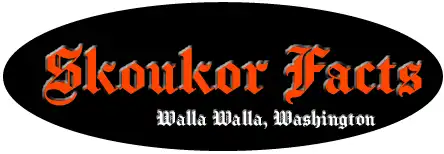

Comments